Smith Corona
 | |
| Industry | Typewriter production (no longer), typewriter supplies, thermal transfer labels and ribbons |
|---|---|
| Genre | typewriters, thermal label technology |
| Fate | Bankruptcy, Reinvented as thermal label and ribbon manufacturer |
| Founded | 1886 |
| Founder | Lyman, Wilbert, Monroe and Hurlbut Smith |
| Headquarters | Syracuse, New York, now Cleveland, Ohio, United States |
Area served | United States |
| Products | Typewriters, thermal transfer labels, thermal transfer ribbons, direct thermal labels |
| Owner | Private |
| Website |
SmithCorona |
Smith Corona is a US manufacturer of thermal labels, direct thermal labels, and thermal ribbons used in warehouses for primarily barcode labels. Once a large U.S. typewriter and mechanical calculator manufacturer, it expanded aggressively during the 1960s to become a broad-based industrial conglomerate whose products extended to paints, foods, and paper. The mechanical calculator sector was wiped out in the early 1970s by the production of cheap electronic calculators, and the typewriter business collapsed in the mid-1980s due to the introduction of PC-based word processing.
Smith Corona did address this by manufacturing word processing typewriters such as PWP 1400 model. Its competitors were Brother, Olivetti, Adler, Olympia and IBM. In late 2010, Smith Corona entered the industrial ribbon and label market.
The company no longer manufacturers typewriters or calculators, but does manufacture large quantities of barcode and shipping labels and thermal ribbons used in thermal transfer printers. Their facility is in Cleveland, Ohio.[1] Smith Corona now competes with distributors of Zebra Technologies supplies, packaging companies like Uline and various other private companies.
History


The company originated in 1886, when the Smith Premier Typewriter Company was established by the brothers Lyman Cornelius Smith, Wilbert Smith, Monroe C. Smith and Hurlburt Smith. The brothers created the first machine to use both uppercase and lowercase letters.[2] This was accomplished with a unique feature that made use of a double keyboard. The advertisements "cunningly boasted" that there was "a key for every character!"[3]
In 1887, the Smith-Premier, the first typewriter to bear the Smith name, was manufactured in Lyman C. Smith's gun factory on South Clinton Street in Syracuse, New York. Alexander T. Brown, an employee, invented the machine, and Wilbert Smith financed the construction of the prototype.[2]
Gun factory
Lyman Smith and Wilbert Smith owned a gun factory in Syracuse and after they hired Brown he sparked Wilbert's interest in financing and improving typewriters. The parts of a typewriter are surprisingly similar to those of a shotgun "so producing the typewriter at the gun factory was logical and easy."[3]
Business was going so well, in 1888, the Smith brothers discontinued shotgun production and strictly produced typewriters with the help of their younger brothers, Monroe Smith and Hurlburt Smith.[3]
Smith Brothers
The Smith Premier Typewriter Company was established in 1886 by brothers; Lyman Cornelius Smith, Wilbert Smith, Monroe C. Smith and Hurlbut Smith who were born in Lisle, New York.[3]
Eldest brother, Leroy Smith, invented the Peerless typewriter in 1891, which "greatly resembled" the Smith-Premier. It had the same double keyboard with 76 characters and also had "blind type" so the typist could not see what was being printed.[3]
 Lyman C. Smith, One of the founders of Smith Premier Typewriter Co., December 31, 1903 |
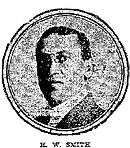 Hurlburt W. Smith, One of the founders of Smith Premier Typewriter Co., July 29, 1904 |
Union Typewriter Company
During 1893, Smith joined with the Union Typewriter Company, a trust in Syracuse which included rival firms Remington, Caligraph, Densmore and Yost.[4]
Not long after, Union took action and blocked the Smith Premier Typewriter Company from using the new front strike design, which allowed typists to see the paper as they typed. As a result, the Smith brothers quit in 1903 and founded L. C. Smith & Bros. Typewriter Company. The new company soon released the "L.C. Smith & Bros. Model No. 2", which was an odd beginning because, a full year later, they released the "L.C. Smith & Bros. Model No. 1." Carl Gabrielson was the inventor of both No. 1 and No. 2 models.[1][4]
In 1906, the Rose Typewriter Company of New York City marketed the first successful portable typewriter. They were "bought out" by Smith in 1909 and the company moved upstate to Groton, New York. At that time, the firm was renamed Standard Typewriter Company.[5]
Typewriter services

To promote usage of the typewriter, the company began by offering typing services at the company headquarters located at the corner of East Genesee and Washington streets in Syracuse. An advertisement on December 27, 1904, for Smith Premier typewriters, touted the Employee Department which offered services such as finding a "competent stenographer (male or female) to operate any make of machine." The company advertised they could provide the services promptly, saving clients time and trouble and "examining" all applicants. Operators could perform duties such as stenographer, typewriter, telegrapher and bookkeeper.[6]
Corona Typewriter Company



.jpg)
With the success of their Corona model in 1914, Standard Typewriter Company was renamed again and became the Corona Typewriter Company.[1] Smith Corona was created when L. C. Smith & Bros. united with Corona Typewriter in 1926, with L. C. Smith & Bros. making office typewriters and Corona Typewriter making portables.[1]
World War II M1903A3 bolt-action rifles
Production shifted from typewriters to various military weapons and parts during World War II. In October 1942, Smith-Corona Typewriter Company began producing M1903A3 Springfield rifles at its plant in Syracuse, with assistance from Remington Arms and High Standard Manufacturing Company. Subcontractor barrels give unusual collector value to some of these 234,580 Springfield rifles. Serial numbers 3608000 to 3707999 and 4708000 to 4992000 carry the Smith-Corona name on the receiver ring. While many M1903A3 rifles manufactured by Remington have 2-groove barrels, most rifles assembled by Smith Corona used 4-groove barrels manufactured by High Standard, and approximately five thousand of the barrels finished by High Standard were from 6-groove barrel blanks made by Savage Arms.[7]
Bolts on Remington M1903A3 rifles have a parkerized finish and are stamped with the letter R at the root of the handle; while Smith Corona bolts are blued and usually stamped with a letter X on top of the handle, although some are unmarked. Some extractors on Smith Corona rifles are stamped with a letter S on the bottom. Stamped steel stock fittings were generally blued, although some were parkerized in late production. Butt plates of the Smith Corona rifles were checkered with 10 or 11 lines per inch, while Remington used 16 lines per inch. Rifle production ceased on February 19, 1944, when supplies of standard M1 Garand rifles were considered adequate. Some of the rifles were never issued, while others were reconditioned in government armories after service use. Reconditioned rifles often have substituted parts from Remington or Springfield manufacture. Most rifles were stored after the war until many were sold through the Civilian Marksmanship Program in the early 1960s.[7]
Mid-century

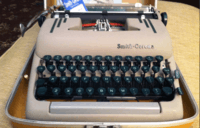
After the war, the company concentrated on making its typewriters more convenient and efficient for use in business offices. Typewriter sales peaked after World War II; in response to a demand for typewriters capable of faster output, Smith Corona introduced electric typewriters in 1955. Electric portables, intended for traveling writers and business people, but later widely purchased for general home use, were introduced in 1957.[1] The new portable electric typewriters would become an essential tool for generations of U.S. high school and college students.
In a diversification move into the wider office technology sector, Smith Corona purchased the Kleinschmidt Corporation in 1956 and Marchant Calculator in 1958, changing its corporate name to Smith-Corona Marchant Inc. Also in 1958, Smith Corona acquired British Typewriters, Ltd. of West Bromwich, England, a company that made small portable typewriters. The company invented the typewriter power carriage return in 1960, the same year it moved from Syracuse to Cortland, New York and opened new corporate headquarters on Park Avenue in New York City. 1960 also saw the company's first foray into the photocopier business with the Vivicopy range of machines, also the accounting machinery market with a range of punch card and tape products manufactured for it in Germany by Kienzle. Still on the acquisition trail, SCM acquired the St. Louis Microstatic Company in 1961. This merger gave rise to the Model 33 Electrostatic Copier, which went on sale in April 1962.
Thus by the mid-1960s SCM had become a major supplier to the office equipment market, offering photocopiers, typewriters and calculating machines.
In 1962, Smith Corona changed its corporate name to SCM Corporation and adopted the tribar SCM logo. In 1967, SCM purchased the Allied Paper Corporation for $33 million. The new paper-making division was named SCM Allied Paper. In the same year, SCM also merged with The Glidden paint company. Glidden was reorganized as the Glidden-Durkee division of SCM. One reason for this merger was that Glidden saw SCM's bid as a "White Knight" bid in preference to an alternative offer from Greatamerica Corporation in Dallas, Texas and General Anniline & Film of New York. In its turn, the acquisition put the (now much larger) SCM itself beyond the reach of any potential hostile bidders of the time. It was also hoped that Glidden's research into paper coatings would be useful in SCM's copier business.
The "Letterpack" product of 1967 was a handset on which personal voice messages could be recorded on small tape cartridges which could be mailed to the recipient (who needed another handset to replay it). The cartridges lasted 3, 6 or 10 minutes, and a pair of handsets cost $7
In 1965 SCM was instrumental in developing smaller computers for the business. The basic computer consisted of an electric typewriter, plug boards, card readers, paper and mag tape readers. The client would purchase a computer and programs specifically designed for their operation. This data processing division was eventually sold to Control Data Corporation in the early '70s.
In 1971, SCM bought the consumer product company Proctor Silex, manufacturers of toasters and can-openers.
In 1973 a new typewriter manufacturing facility employing 1300 people was erected in Singapore.
Cartridge ribbon
In 1973, SCM introduced a cartridge ribbon which eliminated the long-standing problem of getting ink-stained fingers from hand-threading a replacement spool of inked ribbon.
Financial problems
The calculator market was devastated by cheap electronic pocket calculators in the mid-1970s. The typewriter market too was being undermined by cheap imports from the Far East, this being a contributing factor in the closure of the West Bromwich, England plant in 1981. By 1985, personal computers were being widely used for word processing, and SCM launched their first portable word processor, along with the first portable typewriter that included an electronic spelling function. But these products were insufficient to counter the diminishing size of the typewriter market. This, and the corporate bloat associated with being a conglomerate whose many different operating divisions had no inherent business logic, rendered it vulnerable to take-over. Thus, in 1986 SCM was taken over by Hanson Plc, a UK-based vulture capitalist. Hanson immediately disposed of some SCM divisions and the headquarters building in New York City for a significant profit.
The company moved its remaining typewriter manufacturing operations from Cortland to Mexico in 1995 and announced it was cutting 750 jobs as a result of continuing sales declines. Shortly thereafter, the company declared bankruptcy.[8][9] Since 1995, the company concentrated on sales of portable electronic typewriters, as well as typewriter and word processor supplies. The company's then current electronic models featured LCD displays, built-in dictionaries, and spell check and grammar check features.
Thermal label market
After being acquired by a private company during its second bankruptcy in 2000,[10] Smith Corona briefly moved all typewriter manufacturing and typewriter supplies manufacturing to Cleveland, Ohio. Within five years Smith Corona quit manufacturing all typewriters. As the typewriter supplies business continued to decline, Smith Corona decided to leverage its expertise in ribbons and thermal technologies it had previously used in the typewriter business in the growing thermal label market.[1]
Advertisements
 Smith Premier Typewriter – advertisement 1896
Smith Premier Typewriter – advertisement 1896 Smith Premier Typewriter – advertisement, December 27, 1904
Smith Premier Typewriter – advertisement, December 27, 1904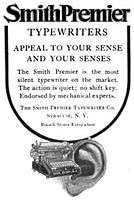 Smith Premier Typewriter – advertisement, October 1905
Smith Premier Typewriter – advertisement, October 1905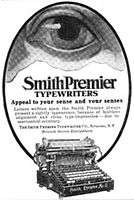 Smith Premier Typewriter Co. – advertisement, October 1905
Smith Premier Typewriter Co. – advertisement, October 1905 Smith Premier Typewriter Co. – advertisement, October 1905
Smith Premier Typewriter Co. – advertisement, October 1905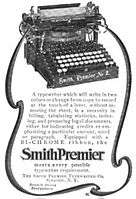 Smith Premier Typewriter Co. – advertisement, October 1905
Smith Premier Typewriter Co. – advertisement, October 1905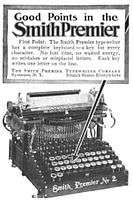 Smith Premier Typewriter Co. – advertisement, December 1905
Smith Premier Typewriter Co. – advertisement, December 1905
See also
References
- 1 2 3 4 5 6 , Smith Corona's Corporate History
- 1 2 "New York, Syracuse". Atlantis, 2010. Retrieved November 3, 2010.
- 1 2 3 4 5 "Typing in Tompkins – Peerless". The History Center in Tompkins County, 2010. Retrieved November 7, 2011.
- 1 2 Bliven, Bruce Jr., (1954). Wonderful Writing Machine,. New York, New York: Random House.
- ↑ "Inventions Built Industries Here". Syracuse Journal. Syracuse, New York. March 20, 1939.
- ↑ "The Smith Premier". Syracuse Journal. Syracuse, New York. December 27, 1904. Check date values in:
|access-date=(help); - 1 2 Canfield, Bruce N. American Rifleman (April 2010), pp. 56–57 & 80–82
- ↑ "Smith Corona Cutting 750 Jobs As Sales Decline", Company News, The New York Times, May 9, 1995
- ↑ Zuckerman, Laurence, "Smith Corona, A Computer Victim, Files For Bankruptcy, The New York Times, July 6, 1995
- ↑ "New Bankruptcy Filing by Smith Corona", The New York Times
External links
- Smith Corona Company
- History of Smith Corona
- History of the Smith Corona Corporation
- History of the Smith Brothers
- A memoir of the British Typewriter Company in West Bromwich during the Smith Corona period
- Company History of the Glidden Company